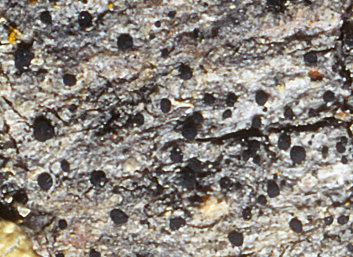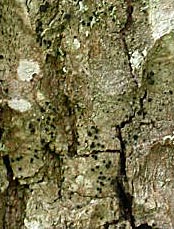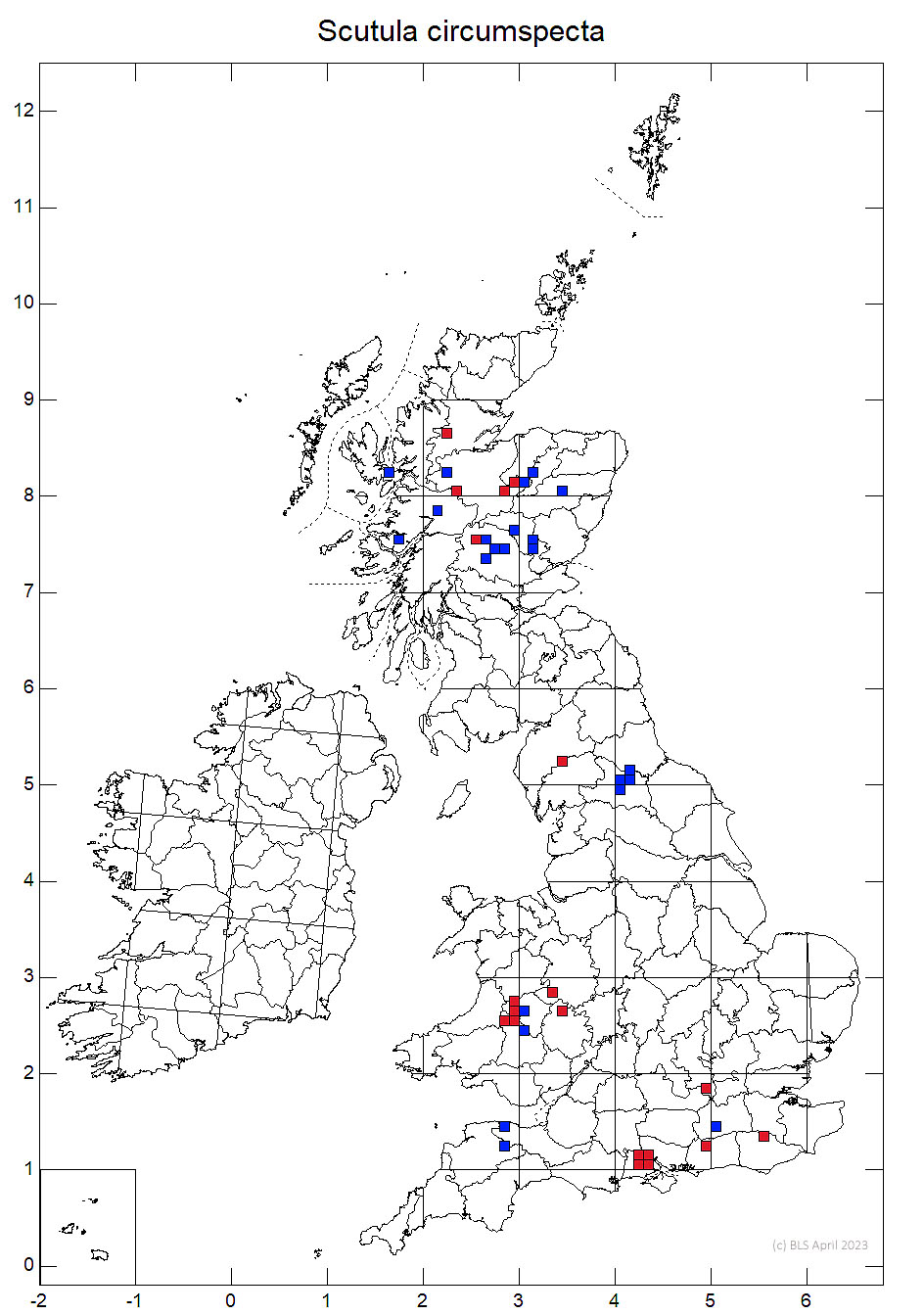Thallus whitish or pale green-grey, thin, irregularly warted but without distinct granules. Apothecia 0.2-0.7 mm diam., flat, black, with a margin.
Distinguished from B. subincompta by the non-granular thallus and pale hypothecium, and from both B. vermifera and B. subcircumspecta by the bacilliform ascospores amd green epithecium. B igniarii has mostly shorter ascospore sand slightly smaller, barrel- to inversely cone-shaped apothecia.
 |
 |
| Photo: Vagn Alstrup | Photo: Ray Woods |
On trunks of mature Quercus, Fagus, Ulmus glabra and old juniper, in old woodlands.
N. America, Asia, Europe, N & S England, E. Scotland and Mid-Wales.
| Location | Grid Reference | Last Rec'd | Recorder | SSSI |
| Brecknock: Ally-y-Gest | SN 8952 | 1969 | A. Pentecost | Yes |
| Brecknock: west of Allt Cynhelyg | SO 0247 | 1998 | R.G. Woods | No? |
| Brecknock: Carn Gafallt - near Elan Village | SN 934650 | 1991 | A.O. Orange | Yes |
| Radnor: Gilfach Farm | SN 963717 | 2011 | R.G. Woods | Yes |
| Radnor: River Wye - Nannerth Fawr | SN 948714 | 1988 | R.G. Woods | Yes |
| Radnor: River Wye - Alpine Bridge | SO 090629 | 1986 | R.G. Woods | Yes |
| Radnor: Dderw | SN 959683 | 1986 | R.G. Woods | No |
| Radnor: Llandeilo, Rhulen & Llanbedr Hills | SO 076465 | 1999 | S.P. Chambers | Yes |
Allt y Gest - on ancient oak trunks in open woodland. (hb NMW)
Allt Cynhelyg - on old ash in a ravine.
Gilfach - The populations noted here by Steve Chambers in 1998 occurred on two oak trees in fields, one at SN963717 and one at SN969719 and on three trees in "vanishingly small amounts" in the small wood on the left bank of the Afon Marteg just below the Gilfach Farmhouse track. The first-noted population was probably on the same tree noted by Ray Woods also at SN963717 in 1989. This tree was revisited by RGW in April 2011 when a small colony covering c.8x4cm with 30 apothecia was found on the WSW-facing side of the tree at 130cm above ground level. A record was made of the % cover of lichens and bryophytes in a 20 square cm quadrat centred on the B. circumspecta. The tree was vertical at this point.
Bacidia circumspecta 10, cf Ochrolechia turneri 20, Homalothecium sericium 15, Parmelia ernstii 5, Phlyctis argena 5, Anisomeridium biforme 5, Frullania dilatata 5, Opegrapha sorediifera 5, Lecanora chlarotera agg. 3, Ramalina farinacea 2, Pertusaria amara 2, Metzgeria furcata 1, undetermined lichen crusts and bark 35.
In June 2011, late in the evening the tree at SN9695571958 was examined and a small fertile colony found on the upslope (south) side at about 1.3m up the trunk. This tree is an ancient oak at the edge of a group of younger trees in a wet patch in the field.The colony covered less than 5sq cm and had c.20 apothecia. There was insufficient time to record a quadrat but Zygodon was abundant and nearby a small cushion of Orthotrichum lyellii testified that this oak had an unusually basic bark. A large limb on the east side of the tree could usefully be propped or some small amount of wood removed to lighten the limb and reduce the risk of damage to the tree from its failure.
Alpine Bridge - this population occurred on the left bank of the River Ithon within the Wye Tributaries SAC and SSSI. Ray Woods searched for it again in March 2011 but could not locate any populations. It may have been on an ancient oak that collapsed into the river a few years ago. An ancient field maple was still present but no trace of this species was seen.
Nannerth Fawr - this population occurred on a tree in the R Wye SAC and SSSI.
Llandeilo, Rhulen & Llanbedr Hills SSSI - this population was spotted on a Welsh Lichen Group meeting on a mature oak below Aberedw Rocks near Pont Shioni in 1999. Subsequent searches by Ray Woods in 2008 and 2010 failed to relocate it.
Dderw, Rhayader. The site was searched by Ray Woods in Feb 2011 but no trace of the species was found. A number of ancient oaks are still present but the bark appeared all rather too acidic.
Carngafallt, South of Elan Village. The tree from which Alan Orange made the record in 1991 was examined minutely by Ray Woods in 2011. One tiny colony with two fruits probably of this species was located on the south side of the ancient oak tree 1.5m up the trunk. The community of which it is part is described in the following 1m x 1m quadrat from the south side of the ancient oak trunk 1.5m up at centre of quadrat. Inclination 90 degrees. Grid ref SN9343065010, Feb 2011. p=present at less than 1% cover. All numbers are approximate percentage cover.
Bacidia circumscripta (cf) p,Ochrolechia subviridis 35, Parmelia cf ernstii 15, Lobaria pulmonaria 10, Pertusaria albescens albescens 8, Homalothecium sericeum 5, Metzgeria furcata 5, Isothecium myosuroides 2, Pyrrospora quernea p, Lecanora chlarotera p, Pachyphiale carneola p, Lopadium disciforme p, Frullania dilatata p, Zygodon sp p, Lepraria sp. p, Pertusaria hemispherica p, Ramalina farinacea p, Pertusaria hymenina p, Ochrolechia turneri p, Melanelia glabratula p, Thelopsis rubella p, Bark 3%.
From the above three detailed observations of associated species it is clear that this lichen requires trees with a significantly more base-rich bark than is now the norm for most Mid Wales oak trees. It appears to be confined to ancient fairly open grown trees in sheltered but quite well-lit sites that typically have a more basic bark. Acid rain must continue to present a major threat to its long term survival.
| UKBAP Signposting Actions: | |
| 1.
|
Monitor the habitat and species at sites, at least every 6 years, to ensure that management maintains and/or expands suitable mature and veteran native trees, paying special attention to threats from excessive shade cast by climbers and evergreen trees and shrubs, particularly invasive non-native species and inappropriate grazing levels, forestry operations or adjacent land uses. |
| 2. | Promote further survey of potentially suitable trees and bring any newly discovered populations into the monitoring/management programme.
|
Woods, R.G. (2003). Lichen Flora of Brecknock. Published by the author.
- Log in to post comments

